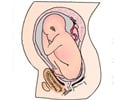HELLP syndrome is a high blood pressure condition affecting 1 percent of all pregnant women that causes hypertension along with end organ damage.

‘HELLP is a severe form of preeclampsia, a pregnancy complication marked by high blood pressure and potential kidney and other organ damage.’





The findings, based on a study of blood samples from a small number of women, suggests that the two conditions have similar underlying biochemistries marked by over activation of a part of the immune system called the alternative pathway of complement. If confirmed in further and larger studies, the test, a modified form of an assay for broken red blood cells known as a Ham test, could be used to identify women who could benefit from medicines to block increased complement activation, according to senior study author Robert Brodsky, M.D., director of the Division of Hematology at the Johns Hopkins University School of Medicine. "The clinical implications from an obstetric point of view are potentially huge," says lead study author Arthur "Jason" Vaught, M.D., a maternal fetal medicine fellow at Johns Hopkins. "If this works, we can reduce pre-term deliveries, stays in the neonatal intensive care unit and other complications for mothers and their babies."
Brodsky was part of a team that developed the modified Ham test that measures levels of components of serum, a protein-rich liquid in blood, and showed it was effective in diagnosing atypical hemolytic-uremic syndrome (aHUS), a genetic disorder in which abnormal blood clots form in small blood vessels in the kidneys. That work was published in 2015 in the journal Blood.
Because aHUS and HELLP syndrome share similar traits -- such as hemolysis, or the breakdown of red blood cells; elevated liver enzymes; a low platelet count; kidney dysfunction; high blood pressure; seizures; and altered mental status - the investigators thought the test also could be used to identify HELLP syndrome.
HELLP is thought to be a severe form of preeclampsia, a pregnancy complication marked by high blood pressure and potential kidney and other organ damage, says Vaught; preeclampsia occurs in 3 to 5 percent of all pregnancies. The acronym stands for a syndrome composed of hemolysis, elevated liver enzymes and low platelet count. Currently, there is no diagnostic blood or biomarker test, and the condition is diagnosed only by the appearance of its symptoms.
Advertisement
In the current study, investigators used the modified Ham test to study serum samples from 14 women with classic or atypical HELLP syndrome, seven women with severe preeclampsia, 11 women with normal pregnancies, and eight healthy non-pregnant women. All pregnant women were at least 23 weeks pregnant.
Advertisement
Next, in a laboratory test-tube experiment they found that mixing serum from women with classic or atypical HELLP together with a monoclonal antibody the blocks complement, resulted in a significant decrease in the killing of cells in the modified Ham test -- from about a 34% kill rate down to a 5% kill rate, the amount seen in healthy individuals.
The results adds to evidence that HELLP is associated with increased complement activation, and that its origins relate to aHUS, Brodsky says. While this may not explain 100 percent of cases, "it probably explains the majority of them and gives us a pathway, complement, to target for potentially treating HELLP syndrome."
Source-Eurekalert















